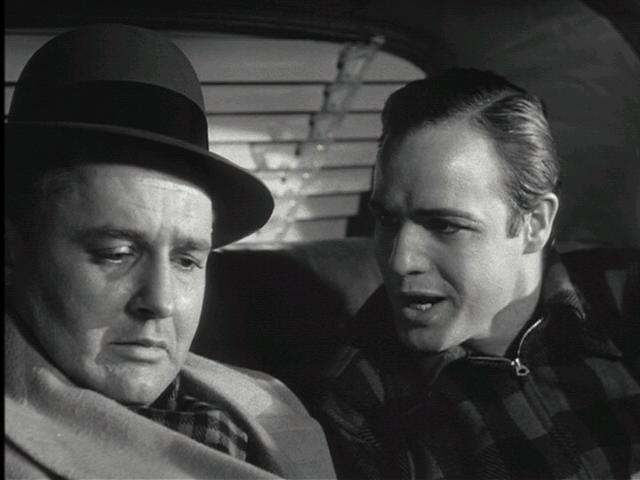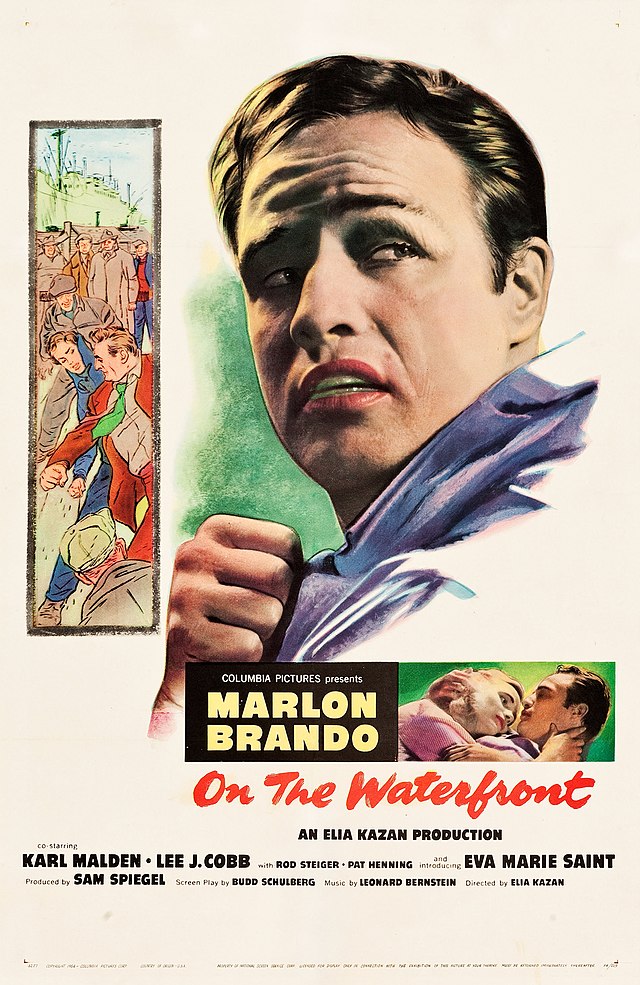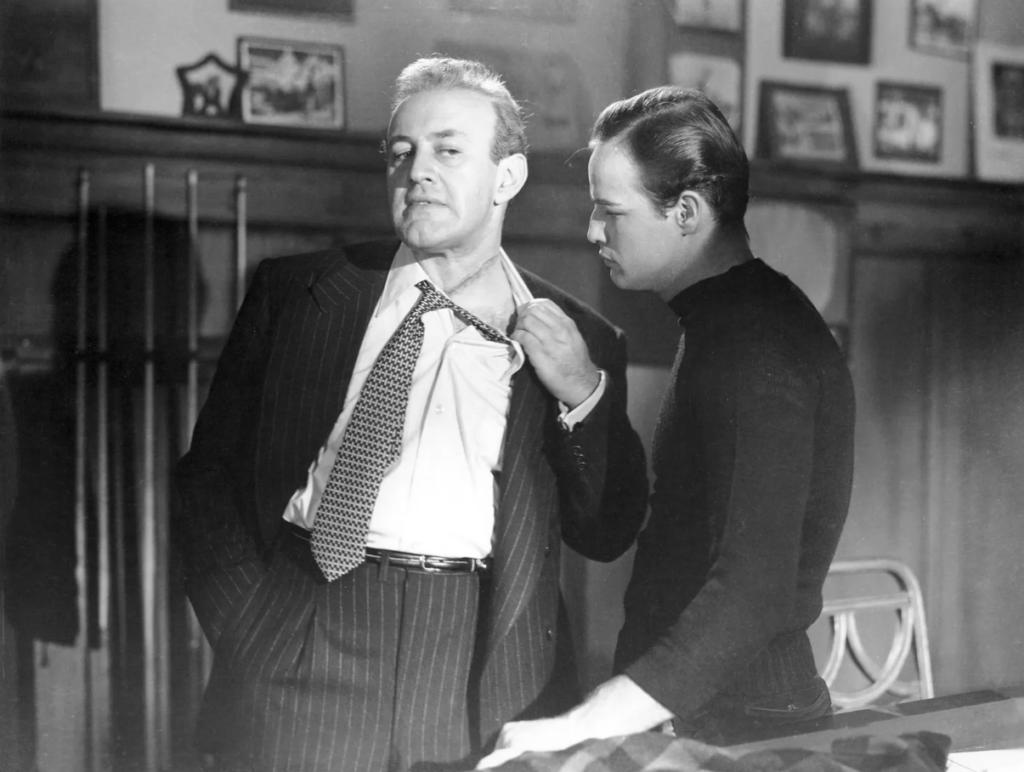
Oscar-winning ‘On the Waterfront’ premiered 70 years ago, with Marlon Brando as a dockworker confronting the Mob
Waterfront Commission still needed today to fight organized crime, New York officials say

On the Waterfront, which debuted 70 years ago this summer, is a ground-breaking tale about dockworkers standing up to a Mob boss on the piers along the Hudson River.
Starring Marlon Brando as Terry Malloy, a longshoreman and former prize fighter, the 1954 movie won eight Oscars, including a Best Actor award for Brando. It also won the Academy Award for Best Picture.
Filmed mainly in Hoboken, New Jersey, the black-and-white movie depicts an era when organized crime figures ruled the docks and determined which obedient longshoremen got paychecks. The Hoboken Historical Museum website has a map showing locations from the movie. “Much has changed since On the Waterfront was filmed in 1953,” the website states.
For years, however, the harbor docks were a rough place, run by Mafia families exerting influence over the International Longshoremen’s Association (ILA).
“Since the 1930s, the Genovese and Gambino borgatas had divided the waterfront loot, which was derived mainly from employee payoffs and from defrauding union welfare and benefit funds,” wrote former New York Times reporter Selwyn Raab in his book Five Families: The Rise, Decline, and Resurgence of America’s Most Powerful Mafia Empires.
The world Raab describes in Five Families is dramatized in On the Waterfront.
“The Gambinos controlled the ILA locals and chicaneries in Brooklyn and Staten Island,” Raab wrote,“and the Genovese domain was the Manhattan and New Jersey piers.”
The movie’s authenticity is enhanced by the casting, which includes real dock workers and others who weren’t professional actors.
In The Ultimate Book of Gangster Movies, authors George Anastasia and Glen Macnow note that three tough characters in the movie are portrayed by “real ex-boxers who fought Joe Louis for the heavyweight title — Tony Galento, Tami Mauriello and the gargantuan Abe Simon.”
Boxing plays an important part in the film. At one time, Malloy believed he had a promising career in the ring, but instead he was part of the Mob’s scheme to throw fights to win rigged bets.

For many viewers, On the Waterfront is remembered for Brando’s line, “I coulda been a contender,” spoken to his big brother, Charley “The Gent” (Rod Steiger), in a taxicab. Charley works for Mob boss Johnny Friendly (Lee J. Cobb) and took part in fixing a fight involving his brother, Terry, costing him a shot at the title.
These intertwined relationships form what Raab calls “the film’s graphic portrayal of mobster treachery, outrageous working conditions, and corruption on the Hoboken piers in New York harbor.”
As The Ultimate Book of Gangster Movies points out, the film also features a “crusading waterfront priest, Father Barry (Karl Malden), and Edie Doyle (Eva Marie Saint, in her movie debut).”
The treachery along the docks has an impact on Malloy’s sense of right and wrong. Edie Doyle is the sister of a man Terry earlier set up to be killed for disloyalty to the Mob. “Of course, he falls for the girl, making things all the more complicated,” Anastasia and Macnow write.
Aligned with Edie at last, Terry turns on the mobsters who abuse and discard others.

‘A muckraking work of art’
The betrayal shown in On the Waterfront reflected experiences the movie’s director and screenwriter encountered, according to The Ultimate Book of Gangster Movies.
Elia Kazan, the director, and Budd Schulberg, the screenwriter, “became Hollywood pariahs” for outing former associates to the House Un-American Activities Committee, the book states. This U.S. congressional committee targeted suspected Communists, resulting in members of the film industry being blacklisted.
“When On the Waterfront came out,” Anastasia and Macnow wrote, “many filmgoers watched the story of a man betraying old friends and colleagues and deemed it an attempt by its two creators to justify their actions.”
Kazan did not disagree, writing in his 1988 autobiography that every day he worked on the film he was “telling the world” where he stood and telling off his critics, according to Anastasia and Macnow. “Regardless of where anyone stands on that issue,” the authors wrote, “it should not detract from the film’s brilliance — and its importance as a muckraking work of art.”
Enduring masterpiece
In a recent email, Anastasia said On the Waterfront is a masterpiece — “one of the best and most realistic Mob movies ever made.”
Anastasia is a veteran Philadelphia newspaper reporter whose other books include The Last Gangster, Blood and Honor and Gotti’s Rules.

“The theme of cooperator-vs.-rat is universal in the underworld, and Brando captures the internal conflict perfectly,” Anastasia said. “Where does your loyalty lie? Where should it? Those are questions that come up every time the government puts a cooperating witness on the stand.”
Larry McShane, a recently retired reporter who worked for the New York Daily News and Associated Press, noted in an email that On the Waterfront is “routinely praised as one of the greatest films in the history of American cinema.”
McShane’s books include Chin: The Life and Crimes of Mafia Boss Vincent Gigante, and, with co-author Dan Pearson, Last Don Standing: The Secret Life of Mob Boss Ralph Natale. McShane has a new Mob book coming out, The Orena Faction: Little Vic and the Last Mafia War, about the Colombo crime family battles of 1991-93. A release date has not been set.
McShane said On the Waterfront “continues to resonate in the new millennium” and still turns up on lists of Hollywood’s most enduring productions.
“The film was widely credited with changing the standard Hollywood approach to filmmaking, with Brando improvising his dialogue and the movie shot in 36 days across the Hudson River at locations around Hoboken, New Jersey — a long way from a Hollywood movie lot,” McShane said.
Docks ‘infested’ with mobsters
To this day, 70 years after the movie premiered, the Mob’s influence on the docks is still a problem, Anastasia said. “The docks in Hoboken, Jersey City and Union City, as well as those in Brooklyn and Manhattan, have always been infested and, to varying degrees, still are,” he said.
McShane said the question of whether the Mob continues to wield influence on the docks led to a recent schism between authorities in New Jersey and New York.
The bi-state Waterfront Commission of New York Harbor, formed decades ago to combat Mob control of dockside unions, “was scuttled just last year in a sign of the changing times on the docks of the nation’s largest city and its New Jersey neighbors,” McShane said.
“New Jersey opted out of the Waterfront Commission in April 2023 after a five-year court fight to win its departure, signaling the end of an organization launched in 1953 — one year before the film,” he said.
At that point, New Jersey Governor Phil Murphy directed the state police to watch the docks on their side. In response, New York launched its own commission to monitor organized crime inside the industry, “while taking a shot at their neighbors across the Hudson River,” McShane said.
New York Governor Kathy Hochul and state Attorney General Letitia James delivered the shot, McShane said, in the following joint statement: “For decades, the Waterfront Commission has been a vital law enforcement agency protecting essential industries at the port and cracking down on organized crime.”
Getting rid of mobsters in the workplace is the right thing to do, Anastasia concluded. That comes through in the movie, which exposes “the greed and treachery that are really the true characters of organized crime.”
“No union worker benefits from the Mob’s control of a union,” Anastasia said.
Larry Henry is a veteran print and broadcast journalist. He served as press secretary for Nevada Governor Bob Miller and was political editor at the Las Vegas Sun and managing editor at KFSM-TV, the CBS affiliate in Northwest Arkansas. Today, he is a senior reporter for Gambling.com.
Feedback or questions? Email blog@themobmuseum.org





